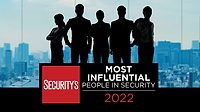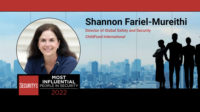Peter Hunt, the Vice President of Security, Brand Protection & Resiliency at Flex, leads the technology manufacturing company’s security function with a holistic view of enterprise risk. As a security leader, Hunt brings his experience from across the security field to his strategic and advisory efforts.
Hunt started in the industry as a security officer at Boston Logan International Airport, after which he transitioned into another security officer position at Digital Equipment Corporation (DEC), one of the largest American computer manufacturers at the time. While studying Criminal Justice at Northeastern University, Hunt moved up in the DEC security department, holding nearly every security position at the firm up to Director of Global Security Operations. When DEC was acquired by Compaq and then subsequently Hewlett Packard (HP), Hunt stayed on to transition and develop the security function at the international computer firm.
His adaptability and understanding of complex risk environments helped him successfully grow the security and brand protection programs at HP. According to Hunt, a specific and contextualized view of risk is a key tool for enterprise security leaders in their roles. “I think what we’re supposed to be doing for a living is really understanding the companies we work for in our industry,” Hunt says. “They do different things, they have different products, different objectives and different go-to-market strategies, and, therefore, they have different challenges and risks.”
To best secure the organizations Hunt has served through his role at Flex, he has honed his ability to assess and simplify the enterprise risk landscape, serving as a security ambassador in leadership conversations. “That’s our role, especially as a chief security officer — to be a trusted advisor to the leadership of the company, especially for those things that aren’t standard business.”
Hunt advised and led the strategic direction of supply chain security and brand protection at HP globally, adapting his security acumen and communications to different markets and audiences. After 12 years, Hunt transitioned from HP to Flex, working his way up to his current role. The tech manufacturer operates in 40 countries, employs more than 200,000 people and runs more than 125 factories around the globe. This complex organization plays an integral role in many global supply chains, creating cutting-edge technologies for various companies, and Hunt ensures the security of each aspect of the enterprise.
The scope of Flex’s role in the global supply chain means that Hunt serves a dual mission of protecting and securing Flex from threats, as well as supporting the organizations for which Flex manufactures and services products. “We’re given next-generation products well in advance of them ever hitting the marketplace,” Hunt says. “Keeping the secrets of the next laptop, the next electronic game, the next cell phone — we’re often doing that for a year or so before it ever hits the market in many places around the world. We take seriously our role of being a ‘safe pair of hands’ for our customers and their market share and reputation.”
Focusing on the larger goal of protecting intellectual property and supporting business resilience is critical to security leaders in the manufacturing space, he says. As a leader with career experience across the security function at large organizations, he has developed the skill of analyzing and determining the importance of specific security threats. Part of this comes down to making sure security and business leadership understand the short- and long-term consequences of certain incidents. The theft of a truck full of raw material isn’t just a loss of raw material — it’s also the loss of all revenue that would have been generated through its use, the idle time at a factory and the wider delivery disruption, he says.
With this context, security leaders can put the right solutions in place to protect their organization, Hunt says. “It’s all about understanding where the risk is in the chain and then making sure that the right things are in place to protect each segment, so product doesn’t leak into the market, but also so the factories keep running and that, ultimately, the finished good gets built on time,” he says.
Securing an organization at the center of the global tech landscape is no easy task, and Hunt knows it’s not one he can accomplish alone. It’s the security leader’s job to get the needed buy-in not only from leadership, but throughout the organization to grow a culture of security across the enterprise. “When you’re trying to operate large organizations, the better feel you have for exactly what the challenge is for team members at various levels, I think you can be much more realistic and practical about the goals that are set,” he says.
Building that trust with leadership and other departments in the enterprise takes time, but security’s investment in those relationships pays huge dividends, according to Hunt. “Trust comes from being able to demonstrate that you’re authentic about what you do — that there is clarity in what you bring to the table for security, resiliency and brand protection. The risk landscape is constantly changing — the criminal elements, the geo-political challenges, natural disasters, unleveled commercial playing fields — but a holistic risk-based approach centered on the goals of the enterprise and aligned with leadership can be an enormous differentiator.”
Providing that sense of clarity and calm is a pivotal task for security leaders, especially in turbulent business environments. “I think security leaders have to be good at operating in the chaos — we bring some stability to what’s often a very messy situation. I think it’s in our DNA to look at things through an analytical lens and be able to get situations under control,” Hunt says. That’s where looking at risk holistically is critically important, he continues. When an incident occurs, security leaders must “understand leadership’s view of the world so you can give them tools to help them get off that ledge and fix it.”
Fostering a holistic, wide-angle understanding of risk has served Hunt throughout his career. “Having had the chance to come up through each level of security has been super valuable in understanding the work,” he says. Hunt’s extensive experience at each level of security helped him become the influential leader he is today — and yet, he doesn’t fall into the trap of the “been there, done that” approach to security. “I think you’ve got to stay agile, you’ve got to stay flexible,” he says.
By connecting with organizational partners, viewing security from all sides of the enterprise, and staying on top of the latest security threats, Hunt ensures the security of the latest developments in technology. In looking forward, Hunt opines the intersection of security, brand protection and resiliency will be much more common. Citing COVID-19, the Ukraine, chip shortages, and ‘what’s next’ — Hunt observes that distilling such realities into how they get in the way of the enterprise’s goals is essential — not broad brush but specific — to best align functions and tailor programs for effective solutions.



